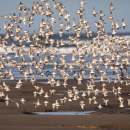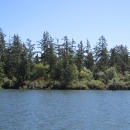About Us
Julia Butler Hansen Refuge was established in 1971 specifically to protect and manage the then endangered Columbian white-tailed deer. The refuge contains over 6,000 acres of pastures, forested tidal swamps, brushy woodlots, marshes and sloughs along the Columbia River in both Washington and Oregon. Diverse habitat that support deer also benefit a large variety of wintering and migratory birds, Roosevelt elk, river otter, reptiles and amphibians, and nesting bald eagles, great horned owls and osprey.
Julia Butler Hansen Refuge is one of over 560 sites in the National Wildlife Refuge System, and one of 56 sites established to benefit specific threatened and endangered species. Managed by the U.S. Fish and Wildlife Service, this system is a vital living heritage, conserving wildlife and habitat for people today and generations to come.
Our Mission
Julia Butler Hansen Refuge for the Columbian White-tailed Deer is a stronghold for the conservation of this once nearly extinct population. Columbian White-tailed deer and other wildlife thrive here in a mosaic of meadows, wetlands, and riparian riparian
Definition of riparian habitat or riparian areas.
Learn more about riparian forests characteristic of the lower Columbia river watershed. Natural processes and management activities support a broad range of native plants and wildlife from Sitka spruce swamps to wild salmon. Refuge staff work closely with a variety of partners, both on and off the refuge, to accomplish Refuge purposes and conservation goals.
Our History
Before the 1920's, much of the mainland and Tenasillahe Island were marshes flooded by the daily rising tides of the Columbia River. The Whakiakum Diking District was formed in the 1920's, at which time the area surrounding and including the now-refuge was diked and drained. These dikes converted wetlands into agricultural lands that were farmed for nearly fifty years until the establishment of the refuge.
The early planning history for protection of the CWT deer began in January 1940, with a report and a plan for the protection of deer habitat by J. Burton Lauckhart, a U.S. Fish and Wildlife Service game biologist. The brief report included purchasing lands for the protection of deer habitat. Nearly 25 years later, a formal discussion to preserve these lands within the Refuge System set the stage for cooperation in establishing protection for Columbian White-tailed deer habitat. The first parcel (totaling 845 acres) was purchased in December 1971, establishing the “Columbia White Tailed Deer Sanctuary.” By July 1972, the sanctuary had gained over 1,900 acres and was renamed the Columbian White-tailed Deer National Wildlife Refuge.
In 1988, the refuge was renamed the Julia Butler Hansen Refuge for the Columbia White-tailed Deer. This refuge is one of only three refuges in the National Wildlife Refuge System named after a woman. Julia Butler Hansen (1907-1988), born Julia Caroline Butler, June 14, 1907, in Portland, Oregon, USA, served as a member of the Unites States House of Representatives from 1960-1974. She represented Washington's Third Congressional District as a Democrat. She was the second woman and first Democratic woman elected to Congress from Washington. She is honored by the Julia Butler Hansen Refuge for the Columbian White-tailed Deer; the Julia Butler Hansen Elementary School in Olympia; and the Julia Butler Hansen Bridge connecting Cathlamet to Puget Island.
An environmental assessment was completed in June 1993. This Columbia River addition included 4,484 acres located in Columbia County, Oregon. During 1998, the addition of the Willamette Industries property to the refuge was approved. The purpose for this addition was specified as “…to preserve native spruce swamp habitat for the endangered Columbian white-tailed deer.” In 2001, the U.S. Fish and Wildlife Service modified the approved refuge boundary to include the addition of the Moores-Wright Tracts which included an estimated 264 acres. A memorandum of agreement was signed in August 2003 between the Bonneville Power Administration, Columbia Land Trust and the Service for the “Acquisition and Management of a Portion of Crims Island." Ultimately, the U.S. Fish and Wildlife Service assumed all management responsibilities of this land. In May 2004, the refuge received a large portion of Crims Island; approximately one-third of the island is still held in private ownership.
Other Facilities in this Complex
Julia Butler Hansen Refuge for the Columbian White-tailed Deer is managed as part of the Willapa National Wildlife Refuge Complex.
A National Wildlife Refuge Complex is an administrative grouping of two or more refuges, wildlife management areas or other refuge conservation areas that are primarily managed from a central office location. Refuges are grouped into a complex structure structure
Something temporarily or permanently constructed, built, or placed; and constructed of natural or manufactured parts including, but not limited to, a building, shed, cabin, porch, bridge, walkway, stair steps, sign, landing, platform, dock, rack, fence, telecommunication device, antennae, fish cleaning table, satellite dish/mount, or well head.
Learn more about structure because they occur in a similar ecological region, such as a watershed or specific habitat type, and have a related purpose and management needs. Typically, a project leader oversees the general management of all refuges within the complex and refuge managers are responsible for operations at specific refuges. Supporting staff, composed of administrative, law enforcement, biology, visitor services, and maintenance professionals, are generally, but not always, centrally located and support all refuges within the complex.
The Willapa National Wildlife Refuge Complex consist of three refuges; Willapa National Wildlife Refuge, Julia Butler Hansen Refuge for the Columbian White-tailed Deer and Lewis and Clark National Wildlife Refuge.
The Complex Headquarters Office is located at 7112 67th Place, Long Beach, WA 98631.



